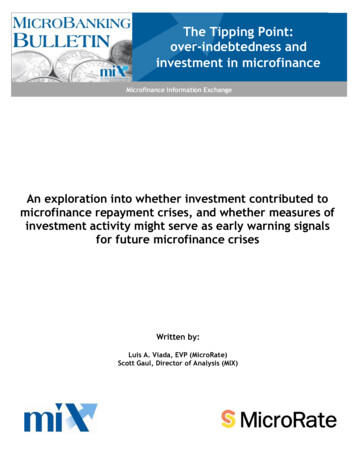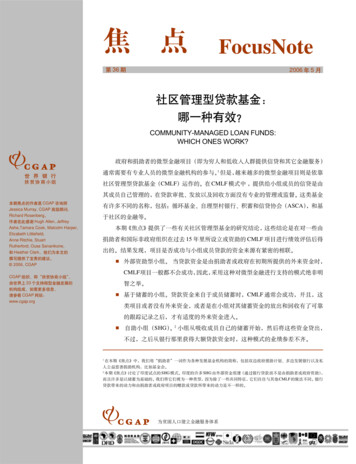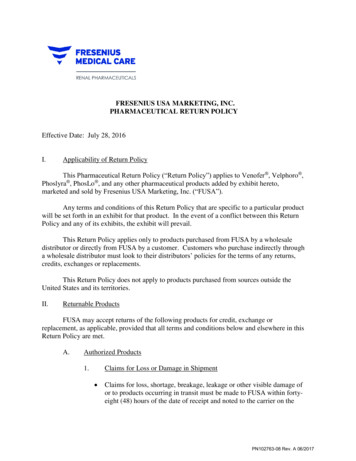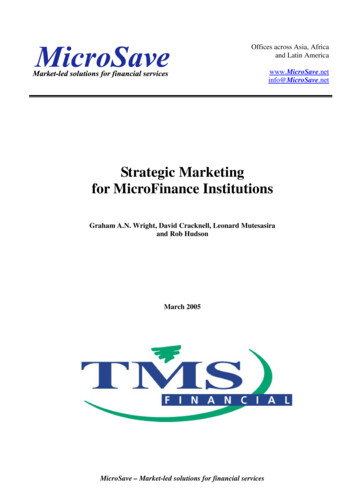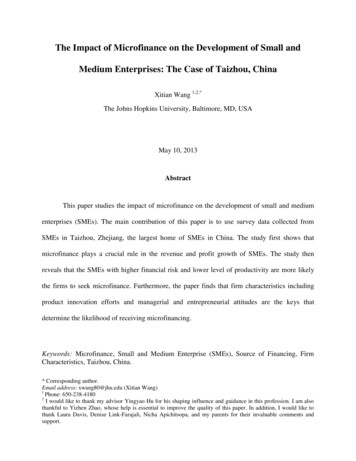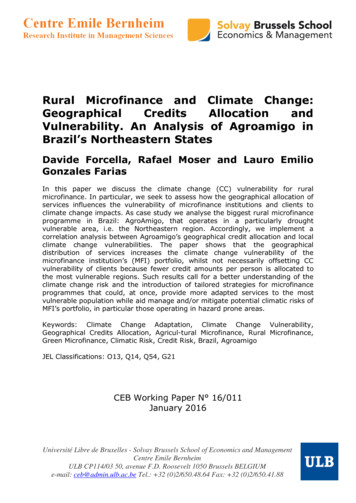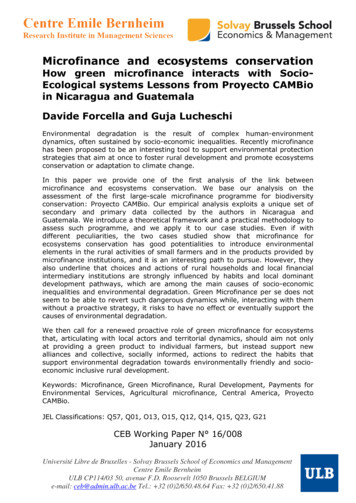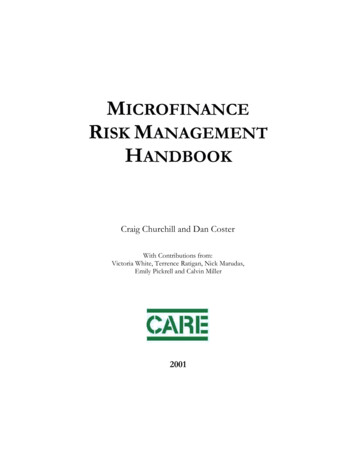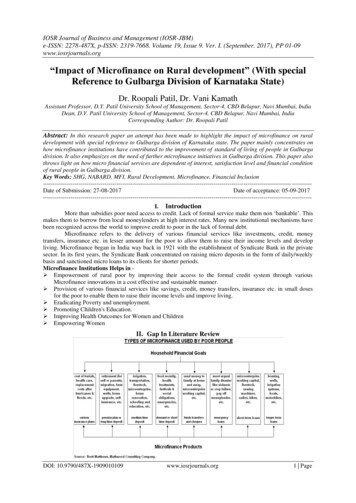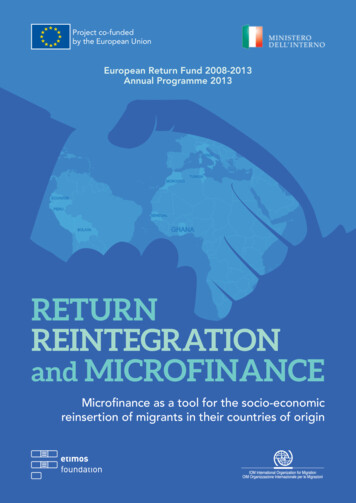
Transcription
Project co-fundedby the European UnionEuropean Return Fund 2008-2013Annual Programme 2013RETURNREINTEGRATIONand MICROFINANCEMicrofinance as a tool for the socio-economicreinsertion of migrants in their countries of origin
RETURNREINTEGRATIONand MICROFINANCEMicrofinance as a tool for the socio-economic reinsertionof migrants in their countries of origin
ByEtimos FoundationEditorial StaffChiara SchiavinottoVeronica MagliDaria FallidoTranslationGiada SondaManaged byDavide LibralessoProject and graphic designPublistampa Arti Grafiche - Pergine Valsugana, ItalyEtimos FoundationVia G. de Menabuoi, 25/a - 35132 Padua - Italye-mail: info@etimosfoundation.orgweb: www.etimosfoundation.orgInternational Organization for Migration (IOM)Liaison Mission in Italy and Coordinating Officefor the MediterraneanVia Nomentana, 62 - 00161 Rome - Italye-mail: ritorno@iom.intweb: www.italy.iom.intAssociazione Formazione Professionale Patronato San VincenzoVia M. Gavazzeni, 3 - 24125 Bergamo - Italye-mail: info@afppatronatosv.orgweb: www.afppatronatosv.org
INDEXWhy this toolkit? . 6123456THE ENTREPRENEURIAL IDEA How is a business idea born?. 8 How to turn the idea into a project. 8THE BUSINESS PLAN Why is the business plan so important?. 9 What is a business plan for?. 9 How to build a business plan. 9THE ENTERPRISE What to do to start your own enterprise . 11 Where can you independently find the financial resources?. 11MICROFINANCE What is microfinance?. 13 What is a microfinance institution?. 14 Microcredit for business. 15THE ELEMENTS OF THE MICROCREDIT FOR BUSINESS The loan. 16 Interest rate. 18 Amortization schedule. 19 Guarantee. 19 Procedures. 20FOCUS ON.GHANA Microfinance in Ghana. 22 The Akosua’s cornermarke . 23 The Organization cooperating with our project. 24 Contact us. 24 IOM in Ghana. 25
Whythis toolkit?This toolkit has been created by Etimos Foundation, in partnership withthe International Organization for Migration (IOM) and the “Vocationaltraining Association of the Patronato San Vincenzo”, in the framework ofthe REMPLOY III project, funded by the Ministry of the Interior, Department for Civil Rights and Immigration and by the European Return Fund,year 2013, Action 3 “Support to the experimentation of new roadmapsfor the voluntary return of particular immigrants categories”.The REMPLOY programme was born in 2012 to answer to the needs andthe ambitions of those immigrants working and residing in Italy who, dueto the economic crisis, had lost their job and were running the risk oflosing their permit of stay, thus becoming irregular on the territory. This iswhy some people started considering the possibility to go back to theircountries of origin and start a new business there, being able to providefor their families.The aim of the programme is to help these migrants and provide themwith the adequate tools for their reintegration, as pre-departure tutoringactivities on how to start a micro-enterprise in the country of origin, orhow to elaborate a business plan to get funds by the IOM in the form ofgoods and services.The first two phases of REMPLOY have obtained positive results. The vastmajority of the assisted migrants have been able to start a micro-enterprise and were satisfied by the assistance received. Some migrants haveshown to have great entrepreneurial abilities and ambitions. Thanks tothese initial experiences the idea to expand the project was born, including the possibility to get even more resources, is to say the access tomicro-credit, every time the socio-economic potential of the reintegration project represents an added value at local level, especially in the jobcreation process.Through the elaboration of this toolkit and the assistance in accessingmicro-credit (a tutoring service led by experts specialized in the micro-finance of the countries of origin), REMPLOY III aims at making this possibility come true and make it accessible to every potential migrant.
As a matter of fact, micro-finance allows accessing a credit even in absence of financial guarantees or stable incomes. Altogether, these reasons make micro-finance particularly suitable to returning migrants, whocannot meet the requirements set by traditional banks to access loans ormortgages.In this context, the REMPLOY III toolkit wants to be a guide for all thoseimmigrants willing to strengthen their reintegration project in their country of origin with an added micro-credit. This toolkit focuses on someof the main countries of origin of the migrants residing in Italy: Bolivia,Ecuador, Ghana, Morocco, Peru, Senegal and Tunisia. It includes the addresses of financial institutes and cooperatives, as well as practical tipsfor the guidance of the migrants in this field.
1THE ENTREPRENEURIAL IDEAHow is a business idea born?A business idea is born from the intuition of an individual or of a groupof people who wants to meet the necessities of a community. Besidesthe intuition, an effective perceptiveness is essential to identify the realneeds and satisfy them offering a good or a service at an establishedprice.How to turn the idea into a projectOnce you have defined the idea, you should decide where to establishyour business, whom to sell your product or service and its price. It isalso crucial to understand where to find the money you need to develop your idea. If you do not have enough money or you are not assistedby a VAR (voluntary assisted return) programme – which offers a grantfor your reintegration – you can access bank loans or other funders. Infact, remember that they will ask you much detailed information andthey will assess your proposal.Here below you can see all the elements that are essential to turn anidea into a project.INTUITIONPERCEPTIVENESSThe entrepreneuris the businessman, who is totallyresponsible for the enterpriseand decides how to use the resourcesnecessary to develop it.8NECESSITYPROJECTAfter the intuition, you need to structureyour idea within a real business plan, ifyou want to become a good entrepreneur. This effort will let you have a middle- and long-term outlook.
THE BUSINESS PLAN2Why is the business plan so important?The business plan is one of the essential elements of every entrepreneurialproject. It is the real roadmap that allows you to understand your goals andthe best way to reach them.Dedicating a little bit of time to write down a business plan it is not worthless, because then you will have a clear action plan to follow and a methodto fulfil it. Just an overall view that will allowyou to start a new successful activity.The business planWhat is a business plan for?is a document summing upthe contents and the characteristicsof an entrepreneurial project.It is used to plan and manageenterprises as well as to communicateyour project with the outside, especiallywith potential funders or investors. Thinking over about your business idea Planning your new activity identifying theways, the time and the resources you willneed Simulating the costs of the activity and, ifneeded, “fix” the project Verifying the coherence and the feasibility of the activity, analysing the different juridical, financial, marketing andorganizational aspects in detail Testing and improving your own entrepreneurial abilities Convincing the future funders and investors on the feasibility andprofitability of your idea.How to build a business plan?Writing a business plan should be as clear,comprehensible and coherent with your entrepreneurial project as possible.Keep in mind that you need a business planto display what you want and to make it clearalso to your funders, in order to convincethem to invest in your project.9
2THE business planIn this scheme we have tried to display the steps you should follow to builda business plan:Display clearly your businessChoose the legal formof your businessyour product/serviceAnalyse and describe the marketin which you are about to operate:1. Observe customer featuresand tastes2. Analyse your competitors’activities3. Identify the best suppliersand partners4. Write a communication planthe business structure1234the entrepreneurial ideaDescribeyour products/servicesFocus on their innovativenaturethe marketDecide your business structure How many people will beworking? How will they be organized?Decide where to establish thevenueSet the middleand long-term aimsSWOT AnalysisList the costs that youwill have to faceForecast which and how muchwill be your revenueUse the specific accountingrecords10567aimsAnalyse the Strenghts,Weaknesses, Opportunities,Threats of your projectEconomic/financialAnalysis
THE ENTERPRISE3What to do to start your own enterprise?Once you have outlined your business plan, you are ready to build yourenterprise. Before starting looking for funding, you should know what thelaw allows and which documents youshould present during the establishment phase.Enterprise and companyIt is important now to mark a clearWe use the word enterprisedifference between the terms “enterto refer to any economical activity aimingprise” and “company”:at producing or exchanging goodsor services. We use company to referIt is fundamental to distinguish the twoto the juridical subject responsibleconcepts. As a matter of fact, so far wefor the business activity, who has rightshave talked about enterprise, especialand obligations deriving fromly in the phases forerunning its materialthe business itself.starting. Now we should move the attention to the company, so to understand what you have to do to establishit in your country.Physical personHowever, first of all you should keep inis just you, consideredmind who will detain the rights and theas an individual among all the otherobligations of the new business.humans.Remember also the difference betweenwho represents the enterprise and whomanages it. We use the concepts of juridical and physical person to distinguish them.Where can you independentlyfind the financial resources?Juridical personis your enterprise, which is entitledby the law to have rights and obligations.The juridical person is also allowed to actand perform juridical acts by meansof the physical people, who actas internal bodies.Now that you know exactly what an enterprise is, that you have planned yourentrepreneurial project and built the business plan, you are ready to findthe funds you need to start your activity. Keep in mind that either you bor-11
3the enterpriserow some money from your relatives, or banks, or financial institutions ormicrofinance, you will have to pay it down, adding also an interest rate.This is the reason why, when you go and ask for a loan, you must have clearideas and be well informed about the credit products that you can access.Summing up:123Developing an entrepreneurial project you may feelconfused and unsure on how to fund it.Thus, read up very well on your business ideaand what you have to do to build it.After preparing the Business Plan you can go to thepotential funders (banks, financial and microfinanceinstitutions) in order to let your project been assessed.The potential funder will assess your project and yourwill to make it happen. In case of a positive answer,a first loan will be granted, to start your business.The loan you have received is not a present,you will have to pay it down according to theconditions agreed with the financial institution,adding an interest rate to every instalment.With the amount received you can finally begin yourproject and start your business.Thanks to your earnings you will be able to give backthe money that you borrowed, interests included,and you will also be able to provide for your family.In the best-case scenario you may even contractother people, if you are earning enough.12
MICROFINANCE4What is microfinance?Basically, the microfinance task is to grant small loans (microcredits)to “ineligible” people, in other words people who cannot offer guarantees to traditional banks but want – or would like – to do a particularcost-effective economic activity.Apart from this financial activity, microfinance offers also other services,usually free, for example business back up during the first steps, orassistance in the activity management, training in matter of education,social aspects, literacy programmes.The typical microfinance clients are: rural areas: small farmers, breeders, artisans, traders urban areas: peddlers, small shopkeepers, services or trade providers.MicrofinanceMicrofinance concern thesupply of: Financial services: credit, savings,management of payment systems,money transfer service andinsurance policy offer. Non-financial services: technicalassistance for the implementationof the business activities.Directed to people who aredeveloping a cost-effective activityand who cannot access the traditionalinstitutions because of their weakeconomic profile (they do not havea fixed income or guarantees).Thanks especially to microcredit, microfinance develops a positive growth withinthe community and gives everyone theopportunity to fulfil a business idea. Whatis more, by means of this idea, the microentrepreneur (you, actually) will also beable to fulfil a personal economic project,through the following activities: Economically speaking, providing foryour own family, assuring your childreneducation and a respectable lifestyle toall the members. Giving to other people the possibility tofind a job within your activity. Contributing to the development of the whole community you live in.In your case, microfinance can be important for these reasons:13
pmentSupportto families It helps you creating your business, because it lends you the moneyyou need and it teaches you how to use it It helps you generating income through your business activity It helps you improving the life conditions of your family.What is a microfinance institution?Microfinance institutionA Microfinance Institution (MFI)is an organization, which providemicrocredits to customers who havedifficulties to access the traditionalfinancial sector. A MFI supportsthe beneficiaries also with tutoringservices and assistance in the businessestablishment and managementand often helps managing the futureprofits of the enterprise.A microfinance institution can belong toone of these main categories: Formal institution: rural banks, development banks, cooperatives Semi-formal institution: non-governmental organizations (NGO) Informal sector: local lenders and shopkeepersThe kind of institutions varies from country to country, from region to region: development banks are flourishing morein Latin America than in other regions,cooperative financial and saving institutions are mainly developed in central andwestern Africa, whilst rural banks prevail in countries like Ghana, Indonesia and Philippines.14
Microcredit for business4Microcredit for business occurs when a microfinance institution suppliesa little loan to microentrepreneurs willing to start and develop a smallentrepreneurial activity.IMPORTANTWhen you get a microcredit for your activity you shouldconsider that developing a sense of responsibility by your sideis essential for your final success in a microfinance programme.When you get a loan you sign a contract, and so you take chargeof returning the money you agreed, within the dates you agreed.Thus, you are facing a risk because if your activity should not giveyou the expected profits, you may risk running into debt beyondyour possibilities.The entrepreneurs getting microcredits do manage small economic activities (microenterprises), which can range from the individual enterprise(made up by just one person) to the cooperative (made up by more people).The characteristic elements of the microcredit for business are: Loans Interest rate Amortization schedule Guarantee Procedures.MicroenterpriseA microenterprise is a business activity “on a small scale”,that benefits of simplified establishment and managementprocedures. The definition changes according to the countries:generally speaking, microenterprises are made up by at most5 employees.15
5THE ELEMENTS OF THE MICROCREDITFOR BUSINESSThe loanIt is the amount that you have been lent and that youwill have to return. Initially, it will be quite small butit will grow with the time if you show to be a reliableclient.On the basis of this amount the interest rate and theamortization plan will be calculated. The loan can begranted to you, for your project, or to a group of beneficiaries, whomyou will be part of and you will be sharing rights and duties, dependingon the nature of the loan granted (individual or group loan).The individual loanIt is the most similar method to the one applied by atraditional bank, but with some innovative elements.Basically, you will apply for a loan to the microfinanceinstitution, which will collect all the necessary data toassess your application; it will examine your businessplan and try to understand your needs. Sometimes, inthe individual loan only, a guarantee may also be required to you or to athird person, usually a relative of yours.The guarantee is different from the one asked by the traditional banksystem: in this case you just need it to show your serious intentions ofstarting an economic activity and you will agree directly with the Microfinance Institution what you can pawn in the credit relation.Here are the elements of this kind of loan:16BeneficiariesIndividual microentrepreneursThe MicrofinanceInstitution relation withbeneficiariesReally close relationship of the credit relation, from the assessment to the monitoring phaseLoan approvalBased on a careful analysis of the projectto be financed
Characteristics of the loanLoans are “tailored” according to the client and the economic activity characteristics.The various amounts of the loan dependon a careful assessment of the client patrimonial situation and the proposed activity.Rapidity in the loan grantGuaranteesCollaterals and/or co-warrantor (relatives)SavingThis is not a fundamental element5The group loanGroups of clients are formed and the loan is grantedon an individual base; this loan should be returnedperiodically and usually does not require any guarantee. Every member of the group is responsible forreturning the loan also for the other members (jointresponsibility). In this case we go beyond the concept of collateral, since the other members of the group give their ownguarantee.It is a kind of loan especially spread in Latin America. Here you see thecharacteristic elements:BeneficiariesIndividual micro-entrepreneursThe MicrofinanceInstitution relation withbeneficiariesRelative close relationship, focused in twomoments: before approving the loan andupon repaymentLoan approvalBased on minimal analysis of the projectCharacteristics of the loanThe credit conditions are constraining:firstly, the new members get small andidentical amounts of money and then,they can ask for higher amounts, provided that they are able to return in time theprevious loans.In addition to this, while the clients gradually pay back the loans and the organization gains confidence with them, it willgrant loans more and more rapidly17
5THE ELEMENTS OF THE MICROCREDIT FOR BUSINESSGuaranteesJoint liability of all the participants, in otherwords every member guarantees the loansof the other group members and nobodywill be able to get other loans until eachof the members will not have returned theamount receivedSavingOften clients are required to pay a compulsory savings rate, usually withheld atthe beginning of the relationGroup CharacteristicsThe groups self-select their members,even though the last ones must not berelatives and should have a similar socio-economic situationInterest rateIt represents the price you will pay for the loan are entitled with. It can becalculated with two different methods: Declining balance: the interest in every period is calculated accordingto the residual balance. The example here below takes into consideration (for simplicity) the constant share capitals to which the interest ofthe period will be added, so to obtain the monthly instalment. This isDECLINING BALANCELoan amount:1.000 Annual interestrate: 20%Loan expiration:12 monthsFrequency:monthlyinstalment18Month Instalment Interest Capital 3,331284,721,3983,33Total1.108,00 108,33 1.000,00
a more complex method if compared to the FLAT one, used especiallyin the urban areas. Flat: the interest rate is calculated every month on the share capital initially granted. It is an easier method, especially used in the rural areas.5flatLoan amount:1.000 Annual interest:20%Loan expiration:12 monthsFrequency:monthlyinstalmentMonth Instalment Interest Capital 33Total1.200,00 200,04 1.000,00Amortization scheduleIt is the schedule you will plan with the microfinance Institution about thedates in which you will return the loan (capital interest rates); thereare two different methods to plan a schedule: One based on the reimbursement shares (capital interest) on weekly,bi-weekly, or monthly basis. This represents the most used option. The other is structured in a first periodic payment of the interest rateand, at the end, the total refund of the capital in a single solution.GuaranteeIt is requested according the kind of activity you would like to start oryou are already running and the kind of loan you have been granted.Sometimes it is not requested, for example in the group loan or in anactivity already started, which does not need any guarantee becausethe earnings self represent a guarantee. It is much more flexible withrespect to the guarantee of the traditional bank system.19
5THE ELEMENTS OF THE MICROCREDIT FOR BUSINESSProceduresOnce you will have started the relation, the microfinance Institution willput into act some specific procedures in order to grant a loan.Analysing the application for the loan and its grant will take a shorttime. The relationship with the institution will be easy and clear and willfollow more or less the steps here below:1Collection of informationabout you (beneficiary)and your business ideaMFI model of Beneficiaries/Clients interview: Description of the economic activities carried out by your familymembers How long have they been doing such activities? Is the activity individual or does it require other people? Howmany? Who are they (relatives and/or employees)? Where will the product be sold? Is there cooperation with other people doing the same economic activity? Is the economic activity officially registered? What is the capital invested in the economic activity in terms ofgoods and equipment? What is the value of the consumption goods and materialsused? Which are the costs and the earnings of the economic activity? Did you ever borrow money to finance your economic activity?From who? (family, friends, bank, local lander, supplier, savingsgroup) How much did you borrow, how long, and under which conditions? If you could get a loan, would you? Under which conditions? How long would it take to return the loan? Are you able to write a budget and a business plan?220Verify the information collected
3456Assessment of the informationcollected5Communication (to you)of the loan granting and planningof the amortization schedulefor the returning of the moneyAuthorization to grant the loanand first microloanFurther advisory (if you will needit) on how to manage your firstloan and activityIMPORTANTRefunding the microloans is important, because themicrofinance Institution trusts you and your commitment in paythem back.If you ever find yourself in difficulty go directly to the person whois helping you within the organization to agree a different way ofrefund, in order not to incur in penalties or added costs.Trust in your possibilities, but also in the people who support you.21
6FOCUS on GHANAMicrofinance in GhanaMicrofinance as an alternative financing tool to the traditional one is quitepopular in Ghana. Traditionally, people are used to save small amountsof money, individually or in groups, helping and lending each other tosupport the farming activities and small businesses.In Ghana the term microfinance is known as a financial sector subordinateto the traditional one, which comprises many kind of organizations, evenvery different among them, that can be gathered in four main categories: Formal Institutions: credit and savingscompanies, commercial, rural and deMicrofinance in Ghanavelopment banks. Semi-formal Institutions: Credit Unions,- 15% of the total population usesNGOs, and cooperatives.microfinance Informal Institutions: Savings and cred- More than 560 microfinance orit associations, informal groups, familyganizations are grouped underunits.the Ghana Association of Micro Government: governmental programmesfinance Companies (GAMC)that make credit available to the most- 850 millions of GHS (216,5 milweak population at favourable condilions) of loans per yeartions.- average monthly interest rate onthe loans between 4% and 6,5%According to the “2000 Population andHousing Census”, the 80% of the Ghanaactive population finance itself throughinformal Institutions, because it is impossible for them to access thecredit, since their vulnerable economic situation.The impossibility for most of the population to access the credit is the reason why it is so difficult for the entrepreneurial system to expand and growin Ghana; that is why microfinance is seen as an answer to this problem.Microfinance clients in Ghana are mostly women, coming both from urbanand rural contexts, working in activities such as farming, food-processing(food preparation and sale), manufacture, small trading and “door-todoor” services.22
6The Akosua’s corner marketAkousa is the seventh client of thecooperative bank of Kumasi; shehas been one of the first womento become part of the rural savings and credit bank of Ghana,which allows deposits and grantsloans to its 300 members, 90% ofwhich are women.“Before starting to work, I was partof an ethic group made up of women and I had the right to small loans– says Akousa – but without anypermanent activity I was forced togo to the village usurers for loans,running more and more in debts. In2008 I joined the bank to improvemy life conditions: with my firstcredit I bought cassava flour and Istarted to produce the fufu (a localdish made of cassava flour, typical in the Ghanaian cookery) and Iresold it at the local market”.Akousa is fifty years old, has two sons, one of them has been studying and working in London for ten years as a waiter in a café,whilst the other works as postman in the native village. As yearspass by, Akousa managed to radically change her condition: “Inthe past it was me going to ask for help to other people, but nowmany people come and ask me for advice. I have a much biggermarket stand now: I sell vegetables, corn cream, fish and palm oil.With the money I earn, I have been able to provide education atthe university for my sons and I also bought a small land in England for my son living there. When he will com
Via G. de Menabuoi, 25/a - 35132 Padua - Italy e-mail: info@etimosfoundation.org web: www.etimosfoundation.org International Organization for Migration (IOM) Liaison Mission in Italy and Coordinating Office for the Mediterranean Via Nomentana, 62 - 00161 Rome - Italy e-mail: ritorno@iom.int web: www.italy.iom.int
